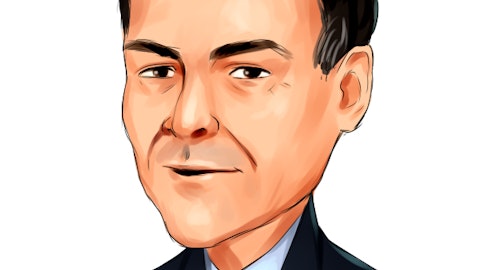Colin Rusch – Northland Capital Markets: Okay. And then just one quick technical question. You know, as…as you look at the…the components and the amm…and the materials inside of your…your cells, the…the quality of lithium, how much leverage do you think you can get as…as you start to see higher-quality lithium aaa…from the supply chain?
Elon Musk: The quality of lithium [unclear] you mean by purity or…
Colin Rusch – Northland Capital Markets: Just in terms of higher…higher purity, I should say.
Elon Musk: Aaa, that’s really not been an issue. And that…that’s not…not a big trade-off or driver of performance. Amm, you know, it…it’s something that we’re constantly looking at with the different the different suppliers and you know trading off different processing mechanisms and different feed stocks that can affect the pricing; the…amm…yeah…the ultimate purity doesn’t really drive performance of the final cell.
Colin Rusch – Northland Capital Markets: Yeah.
Elon Musk: I mean…I mean there are some things that are…are sort of a tricky or…or that matter, like for example like the anode, the…the structure of the…the carbon in the anode is important. I mean we…we use a very high percentage of synthetic aaa…graphite, amm…you know, because that gets sort of a more precise microstructure. Amm, and, yes, so there is some…some potential trade-offs there as to how much aaa…work effort you put into creating the synthetic graphite. Amm, you know, and I…I think generally we wanna probably aim for highly precise aaa…mic…aaa…you know microstructures. So aaa…[unclear] which is a little trickier to do. You don’t want to just have random microstructures, stuff that came out of the ground.
Colin Rusch – Northland Capital Markets: Great, thanks a lot guys.
Operator: Our next question comes from John Lovallo with Merrill Lynch. Your line is open.
John D. Lovallo – Merrill Lynch: Hey guys. Thank you very much for taking my call. Aaa, first question is aaa…we’ve recently had conversations with several of your customers in China and Hong Kong who have placed aaa…firm orders, pretty high trim levels, amm…and now are actually seeking refunds because what they’ve discovered is that the electric wiring at the residential level is so poor that charging equipment is not being permitted in their high-rise buildings. So I guess the question is, I mean are these kind of one-off exceptions, or…or are you guys seeing aaa…you know kind of a trend in this?
Elon Musk: Amm, no, we’re not really seeing a lot of cancellation since…since I have heard. Amm, I mean one…one of the things we have required of customers who place the deposit is that we want to before they take delivery of their car, we want to make sure that they have a wall connector installed, amm…aaa…but you…you don’t really like the…the wire configuration is like what aaa…max amperage aaa…the outlet can be. So some places aaa…may be able to handle amm…an eighty amp outlet some maybe only twenty amps, but aaa…it’s…it’s pretty unusual aaa…to…to…yeah…see this. Amm, something we are doing aaa…aaa…in…in China, another possibility is we’re…we’re putting Superchargers in cities, not just between cities. Amm, this is obviously important in places like, aaa…you know, Beijing, Shanghai, London, San Francisco, aaa…New York, aaa…where at times people may have a challenge with aaa…having a…a…a fixed parking space. I mean…so…so that’s maybe the wiring thing, it’s more like some of those people don’t have a definitive parking space. Amm, they might have street parking or something, you know. Lo…London is particularly tricky one; where there’s – it’s got lot of high-end neighborhoods just have street parking. Amm…
Deepak Ahuja: Yeah, if…if I might add, you know, there…there’s been a lot of amm…questions about, you know, the…the supposed poor quality of the grid in China, but from what we’ve seen, you know, installing aaa…hard-wired charging equipment and Superchargers, it’s actually been, you know, somewhat the opposite, and…and been quite a robust, you know, very new actually – new equipment, new grid. So we…we have not seen very many problems.
Elon Musk: Yeah, no exactly. In fact it’s…it’s exactly as J. B. said. We…we’ve actually found – it’s…it’s been a positive surprise for us in China, not a negative one.
John D. Lovallo – Merrill Lynch: Okay. And then aaa…for my second question, aaa…I think in…in the release you mentioned that North American deliveries were up I think ten percent. Aaa…so this would still…it could be sequent choice… so this would [unclear] imply that they were lower for the first quarter and the second quarter of thirteen, and about in line with the third quarter. Is that a fair characterization?
Elon Musk: Jeff do you want to answer this one?
Jeffrey B. Straubel: Yes, John, just to clarify, we said the orders in North America were up ten percent, not deliveries.
John D. Lovallo – Merrill Lynch: Okay, so how…how were the deliveries in the quarter in North America?
Jeffrey B. Straubel: Aaa, the…the deliveries were down. We were trying to reduce the lead time in Europe. We had a long lead time there, and we were shipping a lot of cars into Europe, so that we come to a more even lead time between North America and Europe.
Elon Musk: Yeah, and I think this is getting back to that what is still not early, this –it…it…it…it…it…it’s a confuse deliveries with demand, deliveries and demand are not the same thing for Tesla. They are for other car companies but not…not for Tesla.
John D. Lovallo – Merrill Lynch: Okay. Thanks very much guys.





